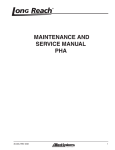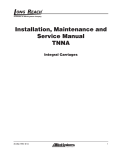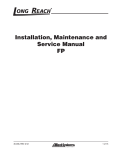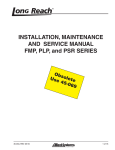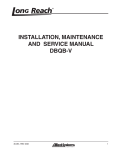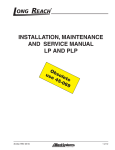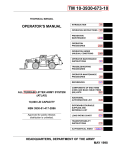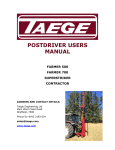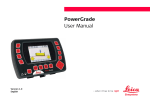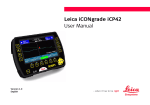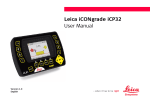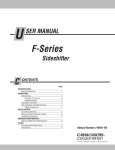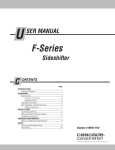Download INSTALLATION, MAINTENANCE AND SERVICE MANUAL QCZB
Transcript
INSTALLATION, MAINTENANCE AND SERVICE MANUAL QCZB 45-060, REV. 3/08 1 of 10 TABLE OF CONTENTS SECTION PAGE SECTION PAGE 1 NAME PLATE LOCATION............. 3 4 SERVICE PROCEDURE 2 SAFETY SUMMARY 2.1 2.2 2.3 2.4 GENERAL INFORMATION....................... 4 LOAD HANDLING................................... 5 LOAD POSITIONING............................... 5 OPERATION CONTROLS.........................6 4.1 4.2 4.3 ATTACHMENT REMOVAL........................9 CYLINDER REMOVAL............................. 9 CYLINDER INSTALLATION.......................9 5 MAINTENANCE SCHEDULE 3 INSTALLATION PROCEDURE 5.1 5.2 SCHEDULE............................................ 10 TORQUE SPECIFICATIONS.....................10 3.1 3.2 3.3 3.4 3.5 TRUCK REQUIREMENTS.........................7 CARRIAGE............................................. 7 HYDRAULICS......................................... 7 ATTACHMENT INSTALLATION................. 7 HYDRAULIC CONNECTIONS...................8 2 of 10 45-060, REV. 3/08 SECTION 1 NAMEPLATE LOCATION NOTE: When you receive your attachment, locate the Long Reach nameplate (upper left corner on the body) and record the information to the blank nameplate tag with the date received in the space provided on the bottom of this page. If the name plate is missing, look for the serial number stamped directly into the metal at the original location and consult factory. APPROX. S/N PLATE LOCATION Date Received: - 45-060, REV. 3/08 - 3 of 10 SECTION 2 SAFETY SUMMARY 2.1 General Information Safety is Everyone’s Responsibility Whether you are new on the job or a seasoned veteran, these safety tips may prevent injury to you, to others, or to the materials you are handling. Always be alert, watch out for others, and follow these suggestions: Attachments Handle Material - Not People. Safety starts with common sense. GOOD JUDGEMENT, PROPERLY MAINTAINED EQUIPMENT, CAREFUL OPERATION, AND PROPERLY TRAINED OPERATORS. 1. Check your equipment before you operate it. 2. Check to make sure the attachment on your truck is the same as on the truck capacity plate. Figure 2-1 9. Never use the attachment or its load to support a man carrying device. 10. Never position an attachment or load over people. (Figure 2-2) 3. Check for hydraulic leaks and cracked hoses or fittings. 4. Check the hydraulic oil level in the lift truck hydraulic reservoir. 5. Check for physical damage to the attachment. If anything looks wrong, unusual or different, report it before using the attachment. 6. When removing / installing dismountable attachments always keep hands and feet free from dangerous positions or pinch points. Never leave a dismounted attachment in a dangerous position. 7. Check to make sure that the dismountable attachment is properly secured to the truck carriage before using the lift truck and attachment. 8. Never stand on top of material being raised, lowered, or transported. (Figure 2-1) 4 of 10 Figure 2-2 11. Never leave an attachment or load in an elevated position. 12. Never reach through the mast of the truck. Keep all parts of the body within the driver’s compartment. 13. Never leave a lift truck unattended without lowering the load to the floor, setting the brake, and turning the truck off. 45-060, REV. 3/08 14. Always operate an attachment from the operator’s seat, never while standing next to the lift truck. 15. Never stand in front of or beside an attachment that is being operated. Never allow another person to approach an attachment that is being operated. (Figure 2-3) 16. Do not allow riders on the truck at any time. fects the stability and steering of the lift truck. 6. Do not use an attachment to open or close boxcar doors. Doing so can severely damage the attachment and cause loss of warranty. Damage to clamp arms may result in product damage. 7. Do not carry loose items or unsupported loads on top of a clamped load. 8. Never allow anyone under a load or under the carriage. 9. Never use chains, cables, or other devices in conjunction with an attachment for load handling. 10. Never clamp loads other than what the attachment was designed to handle. Figure 2-3 17. Always use reverse when carrying a load that impedes full vision. 18. Watch for pedestrians when transporting. Sudden stops can dislodge all or part of a load. 11. Travel slowly around corners. Sound horn on blind corners. Be careful of tail swing and overhead clearances. Watch in all directions. Avoid sudden stops. 12. Do not exceed the specified maximum operating pressure or flow for the attachment. To do so can severely damage the attachment and cause loss of warranty. 2.2 Load Handling 1. All operators must be trained and qualified. 2. Never overload the attachment. Refer to the attachment nameplate for the rated capacity of the attachment. Refer to the nameplate of the truck for the net working capacity of the truck and attachment. Observe the lower of the two capacities. The attachment capacity is the structural rating of the attachment and should not be exceeded. Net working capacity is the truck manufacturer’s rating of the truck/attachment combination. 3. Never use a load to support or move another object. Doing so can easily exceed the holding capacity of the attachment, causing loss of the load. 4. Never lift, lower, side shift, pivot, rotate, or tilt loads while traveling. Repositioning loads while traveling affects the stability of the truck and may impede vision or clearances. 2.3 Load Positioning 1. Always operate an attachment from the driver’s seat. 2. Always lower the attachment if you need to leave the lift truck. Remember a lift truck supporting a load requires your full attention. 3. Never use the attachment or its load to support or move other loads or equipment. 4. Always carry loads as close to the floor as possible, consistent with the surface being traversed. Scraping or bumping the floor surface with the load or the attachment can severely damage the attachment and cause product damage. The mast should be tilted back. 5. Never speed or race a lift truck. High speed adversely af- 45-060, REV. 3/08 5 of 10 5. Always keep the load positioned as close as possible to the horizontal center of the lift truck. 6. Always back down ramps or inclines. Driving forward down a ramp or incline with a clamped load will lessen the stability of the truck. (Figure 2-4) 2.4 Operator’s Controls 1. For clarity, the direction of arm movement is shown on the control handle. To move the arms in the direction shown, pull the handle towards the operator. To move the arms in the opposite direction, the push the handle away from the operator. Clamp Fork Positioner Figure 2-4 7. Do not cross dock boards or dock levelers with the attachment or carriage fully lowered. Ramming the front or rear of the attachment against a dock board can cause severe damage. 8. Always check loads to be handled. If they are broken, unbalanced, loose, or too heavy, advise a supervisor or properly correct the situation prior to handling. 9. Limit lift truck movement to a minimum when high stacking. Limit sideshift movement to a minimum when high stacking. 10. Always be observant when high stacking. Look for poorly stacked loads, overhead obstacles, broken cartons, or damaged products in the stack. Push / Pull Rotate Side Shift Figure 2-5 Note: OSHA or state regulations may require the installation of backrests. We suggest that you check your application against those requirements. 11. Always carry cylindrically shaped loads in the vertical position, not the horizontal. 12. Always clamp loads with the contact pads, if applicable, not the arm or arm base. 13. Never rotate a load that is off center to the centerline of rotation. Severe damage to the rotator could result. 14. Always check the attachment for proper fit and engagement of the truck carriage. 6 of 10 45-060, REV. 3/08 SECTION 3 INSTALLATION PROCEDURE 3.1 Truck Requirements 3.4 Attachment Installation Long Reach attachments have been designed to operate within specific limits. Operating pressures above the stipulated maximum may cause structural damage to the attachment and may result in loss of warranty. Hydraulic flow less than the recommended rates, or the use of small I.D. hoses may reduce operating speed. Higher flow can result in excessive heat buildup, erratic operation and damage to the truck / attachment hydraulic system. 1. Prior to connecting the truck hydraulic system to the attachment, the system must be purged through the filtration system. This will eliminate any contamination that might exist in the auxiliary hydraulic system of the truck. NOTE: it is the responsibility of the dealer and / or the user either to furnish and install the required valving to meet the recommended hydraulic pressures and flow or to arrange installation of the required valving at the truck factory or at Long Reach. 3.2 Carriage The capacity of the truck and attachment combination may be less than the capacity shown on the attachment alone. consult truck nameplate! 2. Purging can be accomplished by installing a jumper line and operating each hydraulic function (clamp, rotate and side shift if equipped) in each direction for a minimum of 30 seconds. (Figure 3-1) 1. The truck carriage must conform to the American National Standard (ASME) dimensions shown in ASME B56.11.4-1992, reaffirmed 2000. 2. Make sure the truck carriage is clean, conforms to ASME recommendations, and the notches are not damaged. NOTE: the model description, found on your shipped invoice, will state the following truck requirements: flow (gpm), psi, and min. truck carriage width. 3.3 Hydraulics 1. The truck hydraulic system must supply to the attachment hydraulic oil that meets the specifications required to operate the attachment properly. 2. When the truck hydraulic system pressures exceed this maximum, a relief valve is recommended in the attachment auxiliary system of the truck or on the attachment. 3. Consult the truck factory and / or Long Reach for guidance. 45-060, REV. 3/08 To Truck To Attachment Figure 3-1, Jumper Line 3. Remove the lower bolt-on hooks and, if applicable, make a note of any factory installed shims. Shims are used to create clearance between the hook and carriage. 4. Center the truck behind the attachment and drive toward the attachment with the mast tilted forward approximately 4 degrees. 7 of 10 5. Line up the locking lug (under the mid plate, if applicable) with the appropriate notch on the truck’s carriage. Check that the bronze side shifting wear strips are in the proper place, if applicable. 6. Make sure roller assembly is in place making contact with lower carriage bar. 7. Slowly raise the truck carriage completely to engage the bolt-on top hooks (See Figure 3-2) with the truck carriage. Tilt carriage back until the unit is against the carriage bottom fork bar (0 degrees). Maximum Clearance 3/32” Shim(s) as Required MAXIMUM CLEARANCE 3/32" SHIM(S) IF REQUIRED Figure 3-3, Lower Hook Clearance Grease Fitting 2. Inspect installation to ensure hoses are not kinked or pinched between the truck carriage and attachment. 3. Operate the attachment continuously for several minutes to determine that all hydraulic connections are secure with no leaks. Figure 3-2, Mounting 8. Install the bolt-on lower hooks. Inspect clearance to the carriage on lower hooks. Adjust the lower hooks for a maximum clearance of 3/32” (see Figure 3-3). Tighten the bolts to 40-50 ft-lbs. 9. Apply grease to bronze top hooks through fittings and spread on entire slide area of mid plate. 10. Check all fittings, connections and bolts for any interference. 3.5 Hydraulic Connections 4. With the mast in the vertical position, open the attachment arms fully. After this procedure, check that the truck’s hydraulic reservoir oil level is at the recommended level. 5. Before placing the attachment in operation check the following: a. Inspect all hoses and fittings for leaks and routing clearance. Be sure to include clearance of jumper hoses to the mast. b. Check the valve and cylinder for leaks. c. Check cotter pins at each end of the cylinder for security. 6. After completing the installation, operate the attachment without a load for several cycles to remove any air in the hydraulic system. Test the attachment with a load to make sure the attachment operates correctly. 1. Install the lines from the truck’s hydraulics to the hydraulics of the attachment. Any alterations to the original attachment may affect performance or safety and result in loss of warranty. 8 of 10 45-060, REV. 3/08 SECTION 4 SERVICE PROCEDURE 4.1 Attachment Removal 4.2 Cylinder Removal 1. Position the attachment arms to the width of the unit’s body. 1. Disconnect the hydraulic connections. 2. Remove the cylinder rod end cotter pin and clevis pin. before disconnecting any hydraulic connections be sure to turn off the trucks power and activate the trucks hydraulic functions in both directions to bleed off the hydraulic pressure. 2. Disconnect the hydraulic connection for the attachment positioning at the cylinders 3. Disconnect the side shift connections. 4. Slightly raise the truck carriage to allow the removal of the bottom mounting hooks. 5. Position the attachment on the edge of a pallet. Lower the attachment so that the lower carriage bar misses the pallet when lowered. Tilt the mast forward to allow the carriage to disengage from the upper mounting hooks and back away. If lowering onto a floor, blocks of wood can be place under the body of the attachment to raise the rear. 6. To reinstall, follow the installation procedure in this manual. 3. before disconnecting any hydraulic connections be sure to turn off the trucks power and activate the trucks hydraulic functions in both direction to bleed off the hydraulic pressure. 3. Remove cotter pin and clevis pin at the base end of the cylinder. 4.3 Cylinder Installation 1. Install the clevis pin and cotter pin into the base end of the cylinder. 2. Attach the hydraulic connections to the cylinder. 3. Extend the cylinder until the rod end hole lines up with the mounting hole. Install the clevis pin and cotter pin into the rod end of the cylinder. 4. Turn on the trucks power and activate the positioning cylinders several times to bleed out trapped air. when hydraulic servicing has been performed, before returning attachment to service be sure to activate the hydraulic functions several times to bleed out trapped air in the system. 45-060, REV. 3/08 9 of 10 SECTION 5 MAINTENANCE 5.2 Torque Specifications 5.1 Schedule Daily: 1. Visually inspect all hoses, fittings, cylinders, and valves for signs of hydraulic leaks. 2. Visually inspect for external damage or cracks. 3. Check lower hooks for proper clearance. Maximum clearance is 3/32 of an inch. 4. If the attachment is equipped with Quick Change Hooks check the slide plate latch for engagement. 100 Hour Maintenance: 1. Complete the above daily checks. 2. Check all hoses and fittings for wear or damage. Inspect for hydraulic leaks. 3. Check for loose or missing bolts. 3!%'RADE#APSCREWS Nominal Size Thread Series 1/4 20 UNC 28 UNF 18 UNC 24 UNF 16 UNC 24 UNF 14 UNC 20 UNF 13 UNC 20 UNF 12 UNC 18 UNF 11 UNC 18 UNF 10 UNC 16 UNF 9 UNC 14 UNF 8 UNC 14 UNF 7 UNC 12 UNF 7 UNC 12 UNF 5/16 3/8 7/16 1/2 9/16 5/8 3/4 7/8 1 1-1/8 1-1/4 4. Check grease fittings to ensure that they are clean and working properly. 200 Hour Maintenance: 1. Re-torque Bronze hook bolts per chart. 250 Hour Maintenance: 0.2500 0.3125 0.3750 0.4375 0.5000 0.5625 0.6250 0.7500 0.8750 1.0000 1.1250 1.2500 Torque (Ft-Lbs) Dry Lubed K=0.20 K=0.15 8 6 10 7 17 13 19 14 31 23 35 26 49 37 55 41 75 57 85 64 110 82 120 91 150 115 170 130 265 200 295 225 430 320 475 355 645 485 720 640 795 595 890 670 1120 840 1240 930 3!%'RADE#APSCREWS Nominal Size Thread Series 1/4 20 UNC 28 UNF 18 UNC 24 UNF 16 UNC 24 UNF 14 UNC 20 UNF 13 UNC 20 UNF 12 UNC 18 UNF 11 UNC 18 UNF 10 UNC 16 UNF 9 UNC 14 UNF 8 UNC 14 UNF 7 UNC 12 UNF 7 UNC 12 UNF 1. Apply grease to bronze top hooks through fittings. Use EP 2 Chassis Lube (See Section 3.4) 5/16 Notes: 7/16 3/8 1/2 9/16 5/8 3/4 7/8 1 1-1/8 1-1/4 10 of 10 Inches Inches 0.2500 0.3125 0.3750 0.4375 0.5000 0.5625 0.6250 0.7500 0.8750 1.0000 1.1250 1.2500 Torque (Ft-Lbs) Dry K=0.20 12 14 25 27 44 49 70 78 105 120 155 170 210 240 375 420 605 670 910 1020 1290 1440 1820 2010 Lubed K=0.15 9 10 18 20 33 37 52 58 77 90 112 130 155 180 280 315 455 500 680 765 965 1080 1360 1500 45-060, REV. 3/08










